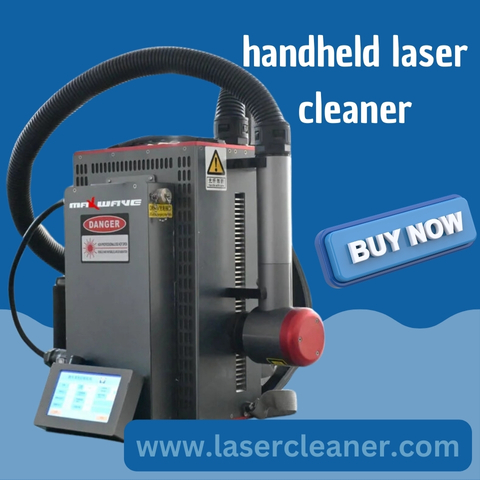When industries face the challenge of rust, paint, oxide layers, or grease buildup on critical components, the traditional methods—chemical cleaning, sandblasting, and grinding—often fall short. Either they cause wear, require extensive safety precautions, or are limited in precision. This is where the handheld laser cleaner disrupts the cleaning game with unmatched precision and performance. But can it truly eliminate years-old corrosion without harming the base surface? Let’s dive deep.
What is a Handheld Laser Cleaner?
A handheld laser cleaner is a portable device that uses a high-energy laser beam to clean surfaces by removing contaminants like rust, paint, oil, or oxide layers. It’s compact, ergonomic, and can be operated manually—making it highly versatile in workshops, factories, shipyards, or even on construction sites.
The core working principle revolves around laser ablation. This method allows the laser beam to heat the contaminants instantly, converting them into plasma, dust, or gas, which is then vacuumed or dispersed. But the real magic lies in how it discriminates between the unwanted layer and the base material.
How It Works Without Damaging the Base Metal
The laser used in these devices is precisely calibrated. Unlike abrasive blasting, the laser targets the uppermost layer based on its absorption characteristics. Contaminants such as rust or paint have different light absorption rates compared to the base metals like aluminum, steel, or copper. The handheld laser cleaner leverages this contrast. It’s a selective process that vaporizes only the surface contaminant while leaving the substrate intact.
A skilled operator adjusts the beam frequency, pulse duration, and power to fine-tune the process. Even years-old corrosion is eliminated in layers without thermal stress to the underlying material. This is critical for preserving original part tolerances in aerospace, automotive, and heritage restoration sectors.
Field Use Case – Aerospace Component Recovery
A U.S.-based aircraft maintenance company recently faced challenges refurbishing aluminum wing brackets from decommissioned jets. The traditional sandblasting method caused surface pitting, leading to rejections during ultrasonic inspection.
They deployed a 200W handheld laser cleaner. With adjustable power settings and pulse control, technicians stripped away the corrosion in less than half the time and retained the structural integrity. Ultrasonic tests passed without surface distortion or microcracking. The parts were reused, saving over $40,000 in new procurement costs.
Precision and Surface Profiling
One major reason the handheld laser cleaner is so effective is its ability to clean microscopically. Engineers and operators can clean only the affected areas without altering the profile of the metal. This is critical in applications where dimensional accuracy is essential, such as injection molds or turbine blades.
Laser cleaning also creates a micro-roughened surface ideal for post-cleaning coatings like powder paint or anti-corrosive primers. The result is improved adhesion and longer-lasting surface protection.
Real Industrial Applications
Let’s examine how different industries utilize handheld laser cleaners:
1. Automotive Manufacturing
Welding prep is a common application. Before spot welding galvanized steel or aluminum parts, handheld laser cleaners are used to strip off oil films and oxides to ensure a pure weld. Post-weld cleaning is also common to remove discoloration or slag.
2. Oil & Gas Industry
Offshore rigs and pipelines are often exposed to salt spray, causing aggressive rust. These surfaces are often irregular and hard to clean mechanically. Laser cleaning easily accesses these tight spots—even curved or vertical surfaces—and removes corrosion without scaffolding or large equipment.
3. Power Plants and Utilities
Turbines, transformers, and reactors need regular maintenance. Handheld laser cleaners are employed to remove insulation residues, paint, or carbon deposits from electrical components without abrasive tools that might short circuit or compromise insulation.
4. Heritage Restoration
Old monuments, bronze statues, and heritage buildings covered in moss, pollution, and oxidation can’t be cleaned with chemicals or scrapers. Handheld laser cleaners enable precision removal without damaging original inscriptions or patina.
Operator Training and Safety
Operating a handheld laser cleaner doesn’t require years of experience. Most systems are equipped with user-friendly control panels and safety interlocks. With the use of protective goggles, gloves, and proper ventilation, the process is both safe and manageable.
Even though the machine is powerful, it’s designed for human interaction. From a lightweight handle to long fiber-optic cables, users can move freely and reach otherwise inaccessible areas. Most systems also include an emergency stop and real-time power adjustment to handle various surfaces on the fly.
Environmental and Economic Impact
One overlooked benefit of the handheld laser cleaner is its eco-friendliness. Since the process requires no solvents, acids, or abrasives, there’s no secondary waste stream to handle. No contaminated water, no media disposal, and no airborne pollutants. Just a clean, dry process that can often be performed indoors with minimal containment.
Economically, although the initial investment may appear high, the long-term return on investment (ROI) is substantial. No recurring material costs, minimal labor, and reduced downtime contribute to fast cost recovery. The device can be used on multiple surface types, increasing its utilization across departments or contracts.
Performance on Complex Surfaces
From turbine blades with deep grooves to injection molds with fine detailing, the handheld laser cleaner shines where brushes and sandblasters fail. Since the laser beam can be finely focused down to millimeters, operators can clean without masking sensitive areas. This makes it ideal for maintenance in confined, sensitive, or precision-critical environments.
Even multi-layered surfaces can be treated layer-by-layer. For example, an old metal beam with several coats of paint, primer, and oxidation can be cleaned back to its base metal in stages, ensuring no damage and excellent restoration.
Durability and Maintenance
Handheld laser cleaners are built to last. The fiber laser source inside most units can last up to 100,000 hours with minimal maintenance. There are no rotating parts, no abrasive belts, and no consumables. Operators need only inspect the protective lens cover periodically and clean the internal filters as per the manual.
This makes the device particularly valuable in remote or rugged environments where equipment failure can lead to costly delays.
Final Thoughts
So, back to the question—can a handheld laser cleaner remove years-old rust without damaging the base metal?
Not only can it do that, but it does so with precision, speed, and safety unmatched by traditional methods. Whether it’s restoring aging machinery, prepping parts for welding, or removing paint from priceless artifacts, the handheld laser cleaner proves to be a powerful tool in modern industrial workflows.
In a world where productivity, sustainability, and precision are increasingly interconnected, adopting this technology is not just smart—it’s necessary. The handheld laser cleaner doesn’t just clean surfaces; it redefines the way we think about maintenance, restoration, and quality assurance.









